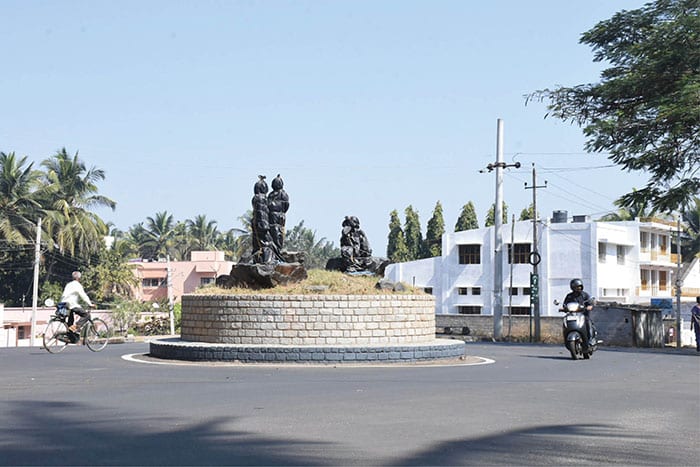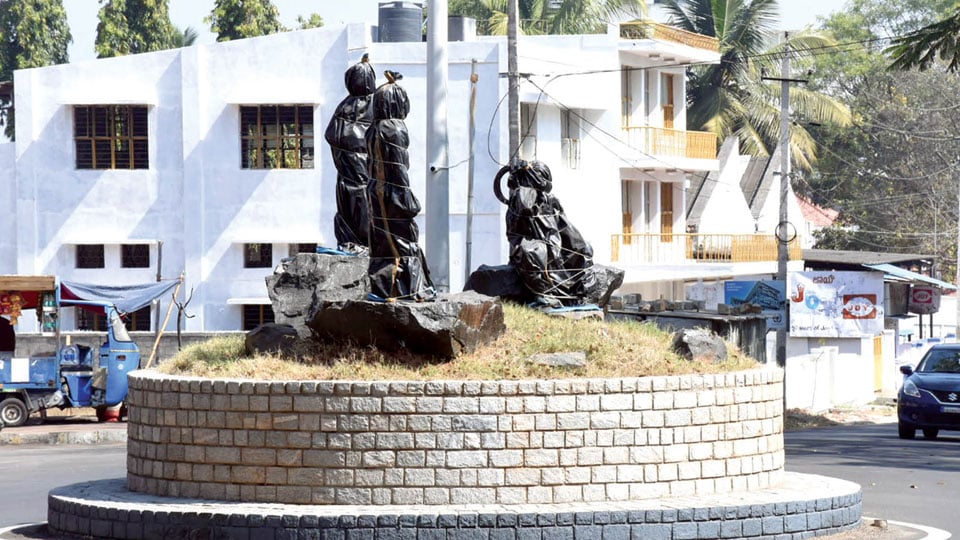
As you drive near the Joy Ice Cream Factory in Yadavagiri, you will see three mummies wrapped in black plastic at the Circle. It’s an eerie sight. But for some of us who know what’s within these black plastic wraps, it is a disappointing sight.
Wrapped within this black tarp is a gift to our city waiting to be opened. The gift is statuary — a group of statues — of ‘Swami and Friends,’ the characters from the first book of a Trilogy by author R.K. Narayan which was adapted to the TV as ‘Malgudi Days.’
The saga of these statues started in 2017 when Tharun Giri, the Managing Director of Windflower Resorts, contacted the Mysuru City Corporation (MCC) to seek permission to develop the Circle in the same way Hotel Grand Mercure developed the Moulana Abul Kalam Azad Circle (Highway Circle) with the elephant-head statue.
Tharun Giri’s family, especially his father, P.V. Giri, has a history of supporting art and artists. He has conducted KHOJ, a one-of-a-kind art festival in Mysuru and the ‘Cha Cha Cha,’ art workshop in 2020.
The MCC approved the request and the Corporators gave them the go-ahead, assuring them that all the approvals needed would be cleared.
Feeling confident, the family decided that since the most famous resident of Yadavagiri was R.K. Narayan and his house being just a stone’s throw away from the Circle, they would install statuary of R.K. Narayan’s most famous characters from his book ‘Swami and Friends.’ The statues would look towards their creator’s house.
Soon, the family contacted our city’s internationally-acclaimed artist N.S. Harsha to help with the project. Harsha then contacted sculptor M.D. Raviraj, also from Mysuru. In just under a month, a studio was set up.
To get the proportions right, three school boys were brought to the studio and dressed up like the three characters from the book; measurements were taken, moulds prepared and metallurgy was decided.

Meanwhile, the Circle was prepped to welcome the sculptures and in about eight months, the three sculptures were ready for installation… but the approval still had not come as promised by the Corporators.
As time passed and with no sign of approval, the sculptures were packed up and stowed away.
But why did a non-political art installation created by reputed artists costing the patron lakhs of rupees — with a noble intention to give back to the city — get delayed for so long?
Well, it was a combination of many issues — The Government’s ‘ban on the statue of individuals,’ the officials’ inability to differentiate between fictional characters from a book and a ‘statue of an individual living or dead’ and the lack of sense of aesthetics among the members of the civic body caused the delay.
Last year, ex-Corporator D. Nagabushan convinced the members from all political parties to support that installation and ex-Mayor Ayub Khan forced the MCC Works Committee to approve this project.
Finally, the statues were erected, but no leader gave a date to inaugurate them. It was a case of “You couldn’t inaugurate with them because they would not provide a date, nor could you inaugurate without them lest they feel insulted.” And so, the sculptures stood there wrapped in black plastic to protect them while reflecting our leaders’ apathy towards art.
Maybe if they were told it was the statue of some leader who belonged to a community which was a large ‘vote bank,’ they would rush to inaugurate it.
The public and politicians must be aware of public art’s importance. Public art is essential in an urban space. More importantly, it also helps build the city’s image and for a tourist city like Mysuru, image is critical. And interesting public art is necessary for a city known for its culture and royal heritage.
To do this, the decision-makers have to have the mindset for it. Here one must applaud former Divisional Railway Manager (DRM) Aparna Garg, who was instrumental in installing the beautiful statuary that welcomes passengers to the Mysuru City Railway Station. The statuary is titled ‘Life is a journey.’
Now thanks to this installation, when passengers get off at the Mysuru Train Station, the first impression they would have is that they have indeed landed in a cultural city.
If Mysuru wants to continue to be a tourist destination, it must encourage public art, but more importantly, it must be professionally curated. City walls painted with anatomically obtuse animals and State tourist spots are not interesting public art. At best, they are tacky and worse, look like an act of vandalism.
Our city can look at the public art created by artists like Shilo Shiv Suleman, who brought life into the K.R. Flower Market in Bengaluru with her murals or Harshvardhan Kadam, whose mural of children is a delight to see at the M.G. Road Metro Station.
As we go on with our daily life, public art can influence how we think and feel as citizens; it has the same effect on tourists. It is common for most of us, especially our administrators and politicians, to think of public art installations as mere aesthetic baubles or worse, a waste of money.
But a good public art created by reputed artists is an investment towards our city’s image. And today, a good image is everything in a hyper-competitive tourist market, where every city is vying for tourist dollars. If we are a royal heritage city and claim to be a cultural city, let it reflect in our public spaces.
Public art can also be about sending a message. One must appreciate the contractor who has bagged the contract for recycling e-waste in Mysuru. He engaged artists from Bengaluru to create sculptures of animals using the e-waste from Mysuru. One must also appreciate the MCC for allowing these sculptures in parks throughout the city to create awareness about e-waste management.
That said, most public art today is tacky, silly and cringe-worthy. They tend to be money-makers — money spent on cheap murals with a kickback in mind and not aesthetics.
Instead of spending money on public art, the Government must encourage private citizens to turn patrons by making the approval process easier. The quality of art and aesthetics will be far superior.
For now, let’s hope some leader will soon agree to inaugurate this beautiful gift given to Mysuru by a Mysurean, sculpted by a Mysurean and inspired by a legend who called Mysuru his home.
e-mail: [email protected]








Hey Vikram
Except that the so called Mysorean Rk Narayan in his life time did not behave as a Mysorean-did not want to speak in Kannada ( it was observed that he did not converse in Kannada) did not accept invitations by students of a high school, who wanted to listen to him to talk about ‘Swami and Friends’ just less than a mile from the house which he shared with his brother in KM Puram. He remained a Tamilian all his life, and clearly showed where his allegiance was by moving to Chennai in later life and abandoning his house in Yadavagiri. |The MCC and the then governor, were intensely lobbied by a cabal headed by Ramachandra Guha, a fellow Tamilian, calling himself a historian, and paid a hefty sum to Narayan’s relatives, for a house which was crumbling!
Vikram , you need to delve deep to carry out gathering facts, when you write in your column.
BTW, why not keep this statue of Swami and Friends inside his house in the garden area?